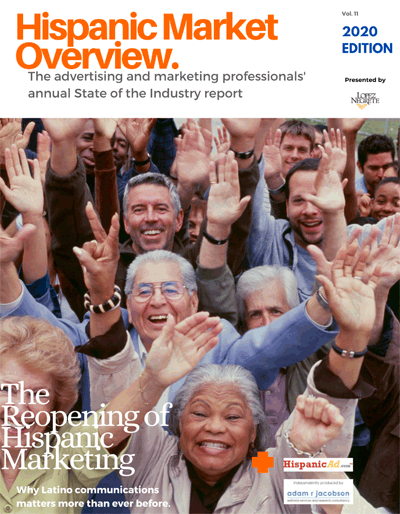 Conversion-driven marketing strategies weren’t born out of the pandemic, but sales-focused campaigns really took a front seat last year when brands around the globe paused their broader marketing efforts. Now, as global ad spending rises, it’s important for brands and advertisers to think beyond the short term—and existing customer bases.
Conversion-driven marketing strategies weren’t born out of the pandemic, but sales-focused campaigns really took a front seat last year when brands around the globe paused their broader marketing efforts. Now, as global ad spending rises, it’s important for brands and advertisers to think beyond the short term—and existing customer bases.
Marketing
Debunking the Myth that Brand Building Doesn’t Drive Sales
Hispanic Marketing NEXT: does the term Multicultural Marketing ostracizes Hispanic Marketing?
![]() It is mid 2021, the new found social awareness is blooming, Corporate America is selling itself as WOKE and the Hispanic Marketing & Media Industry is lost in the conversation. Ostracized is a better term and it is in full display in all Multicultural Marketing conversations that have occurred at the hands of mainstream trade marketing platforms.
It is mid 2021, the new found social awareness is blooming, Corporate America is selling itself as WOKE and the Hispanic Marketing & Media Industry is lost in the conversation. Ostracized is a better term and it is in full display in all Multicultural Marketing conversations that have occurred at the hands of mainstream trade marketing platforms.
‘Great Uncertainty’ Has Transformed Into Clear Recovery
 As retailers head into the second half of 2021, the “great uncertainty” that clouded the nation’s economic outlook earlier in the year has transformed into evidence of an unprecedented recovery from the COVID-19 pandemic, National Retail Federation Chief Economist Jack Kleinhenz said.
As retailers head into the second half of 2021, the “great uncertainty” that clouded the nation’s economic outlook earlier in the year has transformed into evidence of an unprecedented recovery from the COVID-19 pandemic, National Retail Federation Chief Economist Jack Kleinhenz said.
Entrepreneurship beyond Silicon Valley [PODCAST]
 In this episode of The McKinsey Podcast, Diane Brady speaks with senior partners Kim Baroudy and Massimo Mazza about the state of entrepreneurship in Europe and beyond.
In this episode of The McKinsey Podcast, Diane Brady speaks with senior partners Kim Baroudy and Massimo Mazza about the state of entrepreneurship in Europe and beyond.
2020 Hispanic Market Overview Report- DOWNLOAD for FREE
Long-Term Business Vitality Should Outweigh Short-Term Sales Gains
 Our always-online lifestyles have undoubtedly paved the way for highly digitized marketing experiences, which offer brands the benefit of securing sales quickly when an online shop is only a few clicks away. When the pandemic arrived and e-commerce exploded, it only accelerated trends that would have otherwise taken years to reach ubiquity. The significant disruption across businesses over the past 15 months, however, has highlighted a notable shortcoming of marketing efforts that are overly focused on driving short-term sales: they do little to grow a business over the long term.
Our always-online lifestyles have undoubtedly paved the way for highly digitized marketing experiences, which offer brands the benefit of securing sales quickly when an online shop is only a few clicks away. When the pandemic arrived and e-commerce exploded, it only accelerated trends that would have otherwise taken years to reach ubiquity. The significant disruption across businesses over the past 15 months, however, has highlighted a notable shortcoming of marketing efforts that are overly focused on driving short-term sales: they do little to grow a business over the long term.
Pricing and promotions: The analytics opportunity
 The scenario is a familiar one to e-commerce retailers: a supplier increases prices on an item, so a category manager increases the item’s selling price. But this effort to make sales of the item more profitable is promptly undermined by a well-intentioned marketing manager, who lowers the price of the item by 20 percent as part of a promotion.
The scenario is a familiar one to e-commerce retailers: a supplier increases prices on an item, so a category manager increases the item’s selling price. But this effort to make sales of the item more profitable is promptly undermined by a well-intentioned marketing manager, who lowers the price of the item by 20 percent as part of a promotion.
Data & Storytelling: Lifting the Voices of Underrepresented Groups [PODCAST]
![]() In this episode of The New Mainstream podcast, Pedro A. Guerrero, CEO of Guerrero Media and Founder of Hispanic Executive and The Alumni Society, discusses storytelling and data’s importance in achieving diversity and inclusion goals within organizations and marketing and advertising.
In this episode of The New Mainstream podcast, Pedro A. Guerrero, CEO of Guerrero Media and Founder of Hispanic Executive and The Alumni Society, discusses storytelling and data’s importance in achieving diversity and inclusion goals within organizations and marketing and advertising.
Today we earned +75 (revised to +300) new LinkedIn connections on HispanicAd, because of AdAge
 AdAge held their Multicultural Marketing Webinar to discuss opportunities and the current state of Multicultural Marketing. We grade it as a D+, for many reasons. Beginning with only three (3) out of nineteen (19) panelists were Hispanic Market Executives in the conversation. They missed the mark.
AdAge held their Multicultural Marketing Webinar to discuss opportunities and the current state of Multicultural Marketing. We grade it as a D+, for many reasons. Beginning with only three (3) out of nineteen (19) panelists were Hispanic Market Executives in the conversation. They missed the mark.
Sports Fans are Looking to Sports Leagues and Athletes to Support Social Causes
 As consumers continue seeking more from brands than just products and services, the premise of brand promise has grown increasingly central to many core business strategies. And as brands look to showcase their individual promises, U.S. sports fans should be a key audience.
As consumers continue seeking more from brands than just products and services, the premise of brand promise has grown increasingly central to many core business strategies. And as brands look to showcase their individual promises, U.S. sports fans should be a key audience.
The ROI of Inclusivity [REPORT]
 Brands need to start walking the D&I talk. According to a Nielsen custom study commissioned by a third party, The ROI of Inclusivity, only about 10% of national TV ad spend across major categories was on diverse networks in 2020. Share of spend on these networks has declined since 2016 across all categories except electronics. By Roberto Ruiz, EVP – Research, Insights and Analytics
Brands need to start walking the D&I talk. According to a Nielsen custom study commissioned by a third party, The ROI of Inclusivity, only about 10% of national TV ad spend across major categories was on diverse networks in 2020. Share of spend on these networks has declined since 2016 across all categories except electronics. By Roberto Ruiz, EVP – Research, Insights and Analytics
How ANA’s Marketer-Led Initiative Is Reinventing Cross-Media Measurement
 “How many people has our ad campaign reached? And how often have they seen our ad?”
“How many people has our ad campaign reached? And how often have they seen our ad?”
Success Criteria of Marketing Measurement for the Modern Digital Marketer
 Measurement has long been a critical aspect of efficient marketing practices. That said, marketing technology hasn’t always been as rich in its capabilities as it is today. But as martech has improved over the years, engagement with media has grown increasingly more fragmented, elevating the challenges marketers have in proving the returns on their investments (ROI).
Measurement has long been a critical aspect of efficient marketing practices. That said, marketing technology hasn’t always been as rich in its capabilities as it is today. But as martech has improved over the years, engagement with media has grown increasingly more fragmented, elevating the challenges marketers have in proving the returns on their investments (ROI).
TRUST, The New Brand Equity [REPORT]
 Today, our research shows a change in attitude, as consumers believe they have the power to force brands to change (63 percent) and want to exert that power on brands to make society better (78 percent). The deeper dependence on brands forged in the pandemic has made trust an essential purchase consideration, nearly equal to quality and value.
Today, our research shows a change in attitude, as consumers believe they have the power to force brands to change (63 percent) and want to exert that power on brands to make society better (78 percent). The deeper dependence on brands forged in the pandemic has made trust an essential purchase consideration, nearly equal to quality and value.
Influence, not Influencers! [PODCAST]
 Building influence is an online and offline activity that a business or organization needs to develop to create effective persuasion. It all starts with the context of the ask and the planning of the campaign.
Building influence is an online and offline activity that a business or organization needs to develop to create effective persuasion. It all starts with the context of the ask and the planning of the campaign.
The Rise Of Hispanic Products In The U.S. Market
![]() For decades, Hispanic grocers and Hispanic products in mass market grocers have been dominated by food which comes either directly from Latin America or U.S. based companies that try to emulate those of Latin America, like cheeses, spices, and canned goods.
For decades, Hispanic grocers and Hispanic products in mass market grocers have been dominated by food which comes either directly from Latin America or U.S. based companies that try to emulate those of Latin America, like cheeses, spices, and canned goods.
Full Funnel Thinking
 The funnel as a marketing concept celebrated its 100th birthday some time ago. The magnificently named St. Elmo Lewis came up with the acronym AIDA in 1898. He argued that you need different sorts of advertising to capture Attention, stimulate Interest, stoke the flames of Desire, and finally nudge your audience into Action.
The funnel as a marketing concept celebrated its 100th birthday some time ago. The magnificently named St. Elmo Lewis came up with the acronym AIDA in 1898. He argued that you need different sorts of advertising to capture Attention, stimulate Interest, stoke the flames of Desire, and finally nudge your audience into Action.
Marketing industry launches first-ever global diversity and inclusion census
 The first-ever global census of the marketing and advertising industry has now gone live, designed to assess the scale of the diversity challenge facing the profession.
The first-ever global census of the marketing and advertising industry has now gone live, designed to assess the scale of the diversity challenge facing the profession.
Coca-Cola North America Steps up Spending With Minority-Owned Media Companies
 Coca-Cola North America announced plans to nearly double its spending with minority-owned media companies over the next three years.
Coca-Cola North America announced plans to nearly double its spending with minority-owned media companies over the next three years.




























